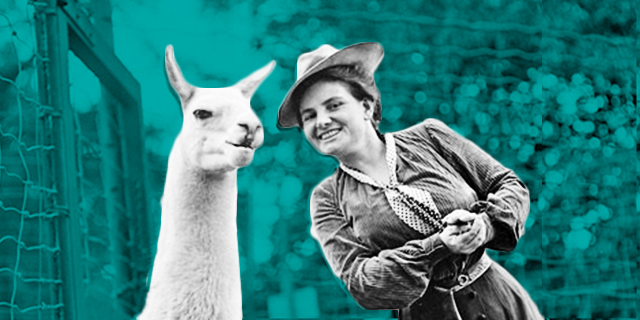
A 40,000-mile journey was nothing for this 19th-century female explorer
Harriet Chalmers Adams was an intrepid turn-of-the-century journalist and explorer. She spent her life traveling through some of the world’s most remote places and promoting fellow female explorers. She traversed Latin America on horseback, retraced Columbus’ route, and was the only female journalist allowed on the French frontlines of WWI.
In the 1880s, long before she became her era’s greatest female explorer, eight-year-old Harriet Chalmers traveled through the Sierra Nevada on horseback with her father. A few years later, at age 11, she impressed a local reporter in Santa Cruz when she swam 500 yards without resting. That same year she stopped her formal education to take lessons from her father and tutors.



When she was 24, Chalmers married Franklin Pierce Adams, and a few years later they set off for Latin America, where they covered 40,000 miles by horse, canoe, foot, and train.
She and Franklin rode through the Andes, across peaks 23,000 feet high. They crossed foot-wide paths, crawled over single-log bridges, and were stuck in a storm so cold her eyelids froze together. She got on just fine “without pink spangly things,” Adams told the New York Times, except for cold cream and smelling salts—which she found also worked to revive a sick mule. When they returned nearly three years later, she gave a lecture at National Geographic and launched a 30-year career as a contributor. She also had acquired a nickname: “Mrs. Marco Polo of the Americas.”
That trip did little to cure her wanderlust. In 1910, Adams traveled across Haiti on horseback. She returned to New York carrying luggage filled with solenodon, a rare venomous rodent only found in the region, which she presented to zoos in New York and Washington, D.C.
Adams made it her mission to visit every country that was or had been a Spanish colony, and retraced the trail of Christopher Columbus from Europe to the Americas. She traversed Asia and during World War I was the first female journalist allowed to visit and photograph the French trenches. She stayed for three months touring the frontline operations.
“There is no reason why a woman cannot go wherever a man goes — and further,” Adams told a newspaper in 1920. “If a woman be fond of travel, if she has love of the strange, the mysterious and the lost, there is nothing that will keep her at home…” Her view hadn’t always been so aligned with feminist thinking. Asked by a reporter a decade earlier about the suffrage movement, Adams replied that she didn’t have the time to think about it.

In 1930, under the headline, “Woman Plans Expedition,” in the New York Times, Adams announced she was setting sail for Gibraltar, carrying on to Spain, France, Egypt, Abyssinia (now Ethiopia), French and Italian Somaliland, Iraq, and the Anglo-Egyptian Sudan. Her goal: to see the coronation of the new emperor of Ethiopia, Haile Selassie. She did that and built enough of a rapport that she later visited him in Europe.
She wrote 21 articles detailing her exploits for National Geographic, more than any other woman published in the magazine’s first half century. In those pieces, she criticized the injustices that she’d observed. “What blessing has European civilization brought to them, which they did not already enjoy?” she wrote after a visit to Peru. “What have they not suffered in the name of the cross which surmounts the hill?”



Very few photographers of either gender were allowed in the trenches of the WWI front. At left, French soldiers hover over a fire in the woods of Lorraine. At right, soldiers in a trench warm up wine.

Adams had no professional training as a geographer and had never been to college, but her color photo slides and adventurous travel style garnered her invitations to speak around the world, often from organizations that had never invited a woman in before.
As her career developed, so did women’s rights in America. Women gained the right to vote, they began going to college in record numbers, and were increasingly working as men went to war. Adams’ awareness of feminism grew too, and she began speaking out on behalf of professional women, particularly activists and working women she encountered in South America who she thought had a head start on U.S. women.
She was the third American woman asked to join the Royal Geographical Society in England. However, the New York-based Explorers Club gave her and other prominent female adventurers the cold shoulder. (The Explorers Club didn’t allow women to join until 1981.)
Men “have always been so afraid that some mere woman might penetrate their sanctums of discussion that they don’t even permit women in their clubhouses,” Adams once said, “much less allow them to attend any meetings for discussions that might be mutually helpful.”

Several female explorers decided to form their own club. In 1925 the Society of Woman Geographers launched with Adams as president. The club recruited adventurous women from across the world to give lectures and share their expertise with the next generation of explorers. Eventually Adams cultivated a membership spanning 39 countries. She led the organization until she moved to France in 1933. She died there four years later at age 61.
Her husband shipped two of her most sacred possessions, a clay urn and a tablecloth, to Gilbert Grosvenor, the editor of National Geographic and a lifelong friend. Adams had requested her book collection be donated to the library in her hometown of Stockton, California. Boxes of books weighing more than a ton were shipped to the library. A half century later, a group of women founded the Harriet Chalmers Adams Society to celebrate her remarkable life. With their perseverance, a bust of Adams now stands in front of the local library.
Published in National Geographic
Leave a Reply